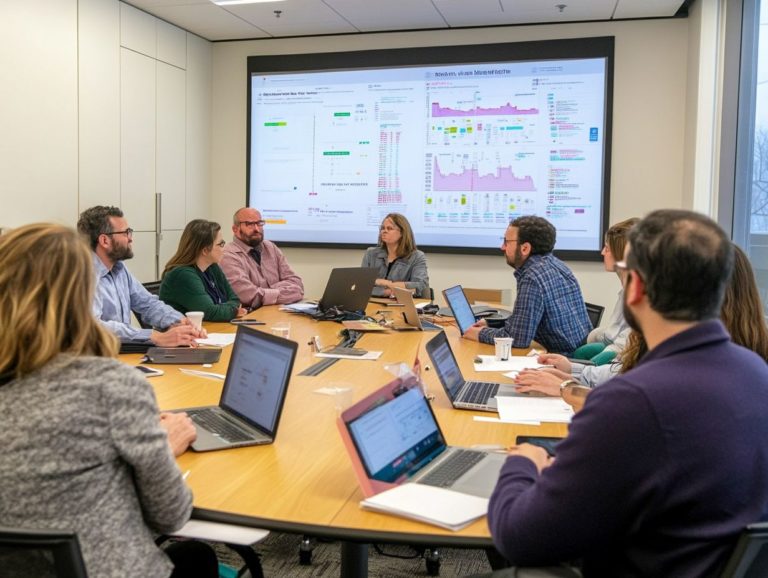PaaS for Mobile App Development: A Closer Look
In today s fast-paced digital landscape, mobile app development stands as a crucial pillar of your business strategy.
Discover how PaaS can transform your app development! PaaS is a cloud service that makes it easy to build and manage applications. It provides you with a comprehensive suite of tools designed to streamline the app creation process.
This overview highlights the benefits of PaaS, such as increased speed, cost savings, and scalability, while also addressing the challenges it presents, like integration and security concerns.
It guides you in selecting the right PaaS provider and shares best practices to enhance your development efforts.
Whether you re a seasoned developer or just beginning your journey, this overview equips you with the insights necessary to leverage PaaS effectively.
Contents
- Key Takeaways:
- Benefits of PaaS for Mobile App Development
- Challenges of Using PaaS for Mobile App Development
- Choosing the Right PaaS Provider for Mobile App Development
- Best Practices for Using PaaS for Mobile App Development
- Frequently Asked Questions
- How does PaaS for Mobile App Development differ from traditional app development?
- What are some popular PaaS options for Mobile App Development?
- How do I get started with using PaaS for Mobile App Development?
Key Takeaways:

PaaS speeds up mobile app development. It also offers cost savings and scalability.
Challenges in using PaaS include integration and data security concerns. To choose the right PaaS provider, consider key factors and practice effective use of PaaS features through collaboration and communication.
What is PaaS?
PaaS is a cloud service that makes it easy to build and manage applications. It offers a robust framework to build, deploy, and manage applications without the headache of maintaining the underlying infrastructure.
With this model, you can focus on what really matters coding and application lifecycle management while enjoying benefits like scalability, cost-effectiveness, and intuitive development tools.
Top-tier cloud service providers such as AWS, Microsoft Azure, and Google App Engine offer comprehensive PaaS solutions that support a range of programming languages and development frameworks.
PaaS truly shines in the cloud service landscape by facilitating smooth collaboration among development teams. You can work in tandem on various aspects of an application without the limitations of hardware.
Unlike Infrastructure-as-a-Service (IaaS), which demands that you manage virtualized hardware resources, or Software-as-a-Service (SaaS), which hands you ready-to-use software solutions, PaaS creates a tailored environment specifically for crafting custom applications.
This level of flexibility not only accelerates your development cycles but also simplifies integration with databases and third-party services. By providing a rich array of development tools, including APIs (Application Programming Interfaces), PaaS enables you to innovate swiftly while keeping the overhead of traditional on-premises development environments to a minimum.
Why Use PaaS for Mobile App Development?
Using PaaS for mobile app development elevates your development process significantly. It provides you with essential tools and resources that streamline coding, deployment, and ongoing maintenance, making it a solution for rapid prototyping.
PaaS solutions offer integrated development environments and promote collaboration among your development teams, ensuring a more efficient workflow.
With built-in features designed for user experience and customer engagement, PaaS allows you to focus on crafting high-quality mobile applications without the hassles of managing underlying hardware and operating systems.
You can quickly prototype and iterate on your ideas, dramatically reducing the time to market for your applications.
The ease of integrating APIs makes it simple to communicate with third-party services, adding a layer of functionality that enhances user engagement.
Successful applications like Airbnb and Slack have harnessed PaaS platforms to develop scalable, high-performing solutions that deliver an exceptional user experience.
By utilizing these powerful development environments, your teams can benefit from automatic updates and maintenance features that keep applications running smoothly. This enables you to concentrate on refining your code and enhancing functionalities without distraction.
Benefits of PaaS for Mobile App Development
PaaS presents a wealth of advantages for mobile app development, making it a compelling option for developers eager to create robust applications without the weight of infrastructure management. For those new to this model, a comprehensive PaaS beginner’s guide can provide valuable insights.
With PaaS, you ll find cost-effective solutions that facilitate seamless scalability, enabling you to respond to increasing user demands and optimize performance effortlessly.
PaaS provides advanced development tools that enhance your productivity, ensuring efficient deployment processes. This ultimately translates to improved application quality and heightened user satisfaction.
Start leveraging PaaS today and watch your app ideas come to life faster than ever!
Increased Speed and Efficiency
One of the standout benefits of using PaaS for mobile app development is the remarkable speed and efficiency it brings to your coding and deployment processes. You can iterate and launch applications at a lightning pace.
Using cloud-based development environments, your team can collaborate in real-time. This effectively reduces bottlenecks and streamlines workflows. PaaS platforms offer pre-built templates and libraries, allowing you to focus on enhancing functionalities and user experience instead of getting bogged down with repetitive tasks.
This collaborative aspect is vital. It nurtures seamless communication among your team members, no matter where they are located. Automating various deployment tasks accelerates delivery times and significantly minimizes the risk of human error.
For example, a prominent fintech company utilized a PaaS solution to cut their development cycle from months to mere weeks. This enabled them to swiftly respond to market demands.
The robust Application Programming Interfaces (APIs) and integrations available within these platforms further enhance your development process. They facilitate quicker connections to external services, resulting in faster, feature-rich applications.
Cost Savings

PaaS offers a smart and cost-effective solution if you’re looking to reduce upfront investments in infrastructure while maximizing your potential for scalable application deployment. With a pay-as-you-go pricing model, you can manage expenses more effectively, paying only for the resources you actually use.
This flexibility helps you invest your budget wisely, allowing you to allocate more to software solutions and development tools that enhance user experience and customer engagement.
Organizations like yours have seen significant reductions in operational costs after transitioning to PaaS. They no longer need to maintain physical servers or other hardware components. For instance, a well-known retail chain adopted a popular PaaS solution and achieved a remarkable 30% reduction in overhead costs within the first year.
This allowed them to reinvest those savings into e-commerce tools that greatly improved online shopping experiences.
This approach to financial efficiency demonstrates how using modern platforms simplifies your development processes while opening avenues for rapid innovation without hefty financial commitments.
Flexibility and Scalability
Flexibility and scalability are essential advantages of using PaaS for mobile app development. They enable you to adjust resources and capabilities according to user demands and business growth.
With PaaS, your applications can evolve seamlessly throughout their lifecycle from initial development to maintenance and future updates without the hassle of major infrastructure changes. This adaptability enables you to swiftly respond to market trends and user feedback, ultimately enhancing customer satisfaction and engagement.
For example, you can automatically scale up resources during peak usage times to accommodate increased traffic while scaling back during downtimes to optimize costs.
PaaS platforms typically come with built-in tools for continuous integration and continuous deployment (CI/CD). This simplifies the process of deploying updates and new functionalities for your team.
By taking advantage of cloud features like microservices and containerization, you can push updates without significant downtime. This ensures your users always have access to the latest enhancements. These capabilities drive innovation and significantly reduce the time-to-market for application enhancements, giving you a competitive edge in today’s fast-paced digital landscape.
Challenges of Using PaaS for Mobile App Development
While PaaS presents a plethora of advantages for mobile app development, it does come with its own set of challenges, especially regarding integration with existing systems and data security.
You may encounter obstacles when trying to connect PaaS solutions to legacy systems or other cloud services. This can complicate workflows and lead to inefficiencies.
Safeguarding sensitive data stored on cloud platforms is paramount. This requires you to implement robust security measures and adhere to stringent compliance standards.
Consider how to address these challenges to fully reap the benefits of PaaS.
Integration with Existing Systems
Integrating PaaS with your existing systems can present significant challenges. You’ll find yourself navigating a maze of compatibility issues and complex workflows.
The necessity to connect legacy applications and databases with modern PaaS solutions often demands additional development efforts and resources. This can hinder your progress. However, with advanced workflow tools and meticulous planning, you can streamline the integration process. This is a crucial consideration as you adopt PaaS.
One major challenge you might encounter is ensuring seamless data flow between on-premises and cloud environments. For example, when you attempt to integrate customer relationship management (CRM) systems with a PaaS-based application, you could face obstacles from inconsistent data formats or outdated APIs.
To tackle these issues, consider leveraging middleware solutions, which are software that connects different systems, or embrace a microservices architecture, which divides applications into smaller, manageable parts. It s vital that you allocate adequate resources for testing and refining these integrations. This minimizes potential outages and enhances the overall user experience.
A proactive approach, coupled with thorough testing, is key to achieving successful outcomes in your PaaS deployments.
Data Security Concerns
Data security is a paramount concern when you use PaaS for mobile app development. You must ensure that sensitive information is thoroughly safeguarded within cloud environments.
With the rising tide of data breaches and cyberattacks, implementing strong security measures is essential to protect user data and maintain compliance with industry regulations. Prioritizing data encryption and access controls is crucial. Conducting regular security assessments will help you mitigate potential risks associated with PaaS.
Stay informed about the latest vulnerabilities and trends in data security. Employ threat modeling techniques to identify potential weaknesses in your applications early in the development process. Incorporating multi-factor authentication significantly enhances access security, ensuring that only authorized personnel can access sensitive information.
Regularly reviewing and updating your security policies, along with conducting thorough checks, will strengthen your approach to safeguarding data in cloud environments. Ultimately, these proactive strategies not only protect user trust but also contribute to a more resilient application ecosystem.
Choosing the Right PaaS Provider for Mobile App Development

Choosing the right Platform-as-a-Service (PaaS) provider is pivotal for any organization aiming to elevate its mobile app development prowess. Don t miss out on the opportunity to enhance your development process!
Each provider presents a unique array of features, pricing models, and levels of support. When making your selection, consider essential factors such as:
- Scalability options
- Integration capabilities
- User experience
Prominent cloud service providers like AWS, Microsoft Azure, and Google App Engine offer distinct resources that can greatly influence the success of your mobile applications.
Key Factors to Consider
When you’re evaluating PaaS providers for mobile app development, focus on scalability, security services, and the array of development tools offered.
A provider that can seamlessly scale resources based on your application needs is essential for accommodating fluctuating user demand and ensuring optimal performance. Comprehensive security is paramount in safeguarding sensitive data and maintaining compliance with industry regulations.
Don t miss out on pricing structures that align with your budget and growth projections, as well as the quality of customer support available. For example, some platforms offer tiered pricing, allowing you to pay only for what you use. This provides flexibility as you expand.
Responsive customer support can be a game changer when issues arise. A telling example is how Company X significantly improved its app’s performance after switching to a provider renowned for its 24/7 support and extensive documentation. This illustrates the critical role a reliable PaaS provider plays in your development strategy.
Start your journey by selecting the right PaaS provider today!
Best Practices for Using PaaS for Mobile App Development
Implementing best practices while utilizing PaaS (Platform as a Service) for mobile app development is crucial for maximizing the advantages of this cloud computing model. It ensures efficiency, enhances collaboration, and maintains quality throughout the development process.
Take full advantage of the unique features provided by your chosen PaaS provider, such as real-time data access and intuitive development tools. These features boost productivity and streamline your workflows.
Cultivating effective collaboration among development teams is vital. It helps uphold the quality and consistency of your applications.
Effective Use of PaaS Features
To unlock the potential of PaaS, make the most of the platform’s features designed to streamline mobile app development and elevate your productivity.
Leverage cloud capabilities like automated deployment, database integration, and integrated development environments. These tools allow you to code more efficiently and roll out application updates quickly.
Utilizing analytics tools provides invaluable insights into user behavior. This information guides your future development efforts and enhances customer engagement.
Consider the ease of scaling applications in response to user demand. This capability minimizes downtime during peak usage, ensuring a seamless experience for your users.
For example, when a social media application goes viral, you can quickly adjust resources without manual intervention.
Integrating third-party APIs into your development process is straightforward. This allows you to enrich your applications with essential functionalities like payment processing and social sharing capabilities.
A case study of a startup using a popular PaaS demonstrated a 30% reduction in development time, showcasing how these features drive efficiency and spark innovation in mobile app projects.
Collaboration and Communication with PaaS Provider
Effective collaboration and communication with your PaaS provider are essential for navigating the mobile app development process and achieving optimal results.
Establish clear lines of communication so your development team can efficiently address challenges, seek support, and share feedback. Actively engaging with your PaaS provider taps into their expertise and resources, creating a collaborative environment that enhances the quality and performance of your mobile applications.
This relationship relies on setting expectations early and maintaining regular check-ins to adapt strategies as your needs evolve. Transparency is crucial. Discuss progress, setbacks, and milestones openly with your provider to foster a culture of trust and accountability.
Successful partnerships often utilize shared dashboards or collaborative project management tools. These tools enable real-time updates and collective input.
By prioritizing responsiveness, you ensure that you meet deadlines and adapt swiftly to shifts in project requirements, maximizing the effectiveness of your partnerships.
Frequently Asked Questions

What is PaaS for Mobile App Development and why is it important?
PaaS for Mobile App Development refers to a cloud-based platform that provides developers with tools to create mobile apps without managing the underlying infrastructure. Understanding PaaS: key features and benefits is essential because it makes developing apps easier and faster!
What are the key features of PaaS for Mobile App Development?
Key features of PaaS for Mobile App Development include scalability, multi-platform support, real-time collaboration, and integration with various tools and services. These features help developers build high-quality, robust, and efficient mobile apps.
What are the benefits of using PaaS for Mobile App Development?
Using PaaS for Mobile App Development offers benefits such as reduced development time, lower costs, a simplified deployment process, and improved collaboration among team members. It also allows for better scalability, flexibility, and access to cutting-edge tools and technologies.
Explore PaaS options for application development for your next mobile app project and see how they can transform your development process!
How does PaaS for Mobile App Development differ from traditional app development?
PaaS, or Platform as a Service, simplifies mobile app development. It removes the hassle of managing servers and databases.
This approach fosters collaboration and provides ready-to-use tools, making app development faster and easier.
What are some popular PaaS options for Mobile App Development?
Ready to explore the best PaaS options for mobile app development? Here are some top choices: Google App Engine, Microsoft Azure, Salesforce Heroku, and AWS Elastic Beanstalk.
Each platform offers unique features, so choose one that fits your development needs.
How do I get started with using PaaS for Mobile App Development?
To start with PaaS for mobile app development, sign up with a provider of your choice. Familiarize yourself with their tools and resources.
It’s helpful to know some programming languages like Java or Swift and frameworks like React Native or Flutter.






